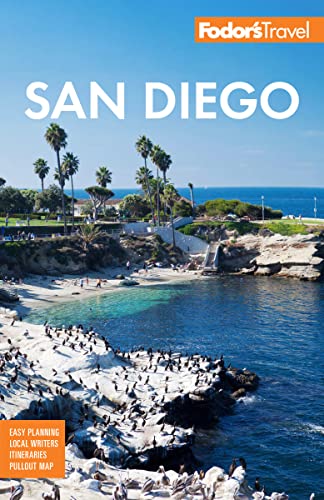Cabrillo National Monument
Cabrillo National Monument marks the site of the first European visit to San Diego, made by 16th-century Spanish explorer Juan Rodríguez Cabrillo on September 15, 1542. Cabrillo called the spot San Miguel. Today the 166-acre preserve is one of the most frequently visited national monuments.
Catching sight of a whale from the cliffs of Cabrillo National Monument can be a highlight of a wintertime visit to San Diego. More accessible sea creatures can be seen in the tide pools at the foot of the monument’s western cliffs.
Trails lead down the hillside through sagebrush and cactus, and overlook points at 430 feet offer unobstructed views of the desert mountains, Downtown, and beyond.
Restrooms and water fountains are plentiful, but, except for the Visitor Center's vending machines, there’s no food. Exploring the grounds consumes time and calories; pack a picnic to enjoy with the views.
Service Information
The informative visitor center, located next to the statue of Cabrillo, and the lighthouse give a historical perspective to this once-remote promontory. The center presents films and lectures about Cabrillo’s voyage, the sea-level tide pools, and migrating gray whales.
1800 Cabrillo Memorial Dr., Point Loma 619/523–4285 www.nps.gov/cabr $20 per car, $10 per person entering on foot or by bicycle, admission good for 7 days. Park daily 9–5.
A Half Day at Cabrillo National Monument
A statue of Cabrillo overlooks Downtown from a windy promontory, where people gather to admire the stunning panorama over the bay, from the snowcapped San Bernardino Mountains, 130 miles north, to the hills surrounding Tijuana to the south. The stone figure standing on the bluff looks rugged and dashing, but he is a creation of an artist’s imagination—no portraits of Cabrillo are known to exist.
The moderately steep Bayside Trail, 2½ miles round-trip, winds through coastal sage scrub, curving under the cliff-top lookouts and taking you ever closer to the bay-front scenery. You cannot reach the beach from this trail and must stick to the path to protect the cliffs from erosion and yourself from thorny plants and snakes—including rattlers. You’ll see prickly pear cactus and yucca, fragrant sage, and maybe a lizard, rabbit, or hummingbird. The climb back is long but gradual, leading up to the old lighthouse.
Old Point Loma Lighthouse’s oil lamp was first lighted in 1855 and was visible from the sea for 25 miles. Unfortunately, it was too high above the cliffs to guide navigators trapped in Southern California’s thick offshore fog. In 1891 a new lighthouse was built 400 feet below. The restored old lighthouse is open to visitors. An exhibit in the Assistant Keepers Quarters next door tells the story of the Old Lighthouse, the daily lives of the keepers, how lighthouses work, and the role they played in the development of early maritime commerce along the West Coast. On the edge of the hill near the old lighthouse sits a refurbished radio room containing displays of U.S. harbor defenses at Point Loma used during World War II.
Whale-Watching
The western and southern cliffs of Cabrillo National Monument are prime whale-watching territory. A sheltered viewing station has wayside exhibits describing the great gray whales’ yearly migration from Baja California to the Bering and Chukchi seas near Alaska. High-powered telescopes and binoculars—available from the visitor center—help you focus on the whales’ waterspouts. Whales are visible on clear days from late December through early March, with the highest concentration in January and February. Note that when the whales return north in spring, they are too far out in the ocean to be seen from the monument.
Tide Pools
When the tide is low you can walk on the rocks around saltwater pools filled with starfish, crabs, anemones, octopuses, and hundreds of other sea creatures and plants. Tide pooling is best when the tide is at its lowest, so call ahead or check tide charts online before your visit.




